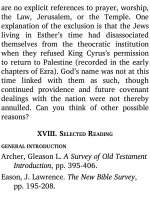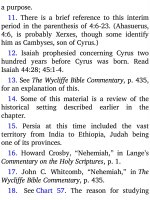Jensens survey of the old testament adam 87
Bạn đang xem bản rút gọn của tài liệu. Xem và tải ngay bản đầy đủ của tài liệu tại đây (117.95 KB, 4 trang )
major campaigns were completed.
The
land
originally
promised
to
Abraham’s seed extended from the “river of
Egypt”5 to the “great river” Euphrates (Gen
15:18). The same promise was con rmed to
the Israelites in the days of Moses (Exod
23:31), and again to Joshua (Josh 1:4).
These were the two ideal limits of in uence,
from Egypt, the one world power on
Palestine’s southwestern border, to Babylon,
the power on its eastern side. One can easily
recognize the strategic location of Canaan
with reference to the rest of the world of
Israel’s day. It was the connecting link, the
point of balance and the spot on which the
major land and sea routes converged.6 The
explicit details of the geographical
boundaries of the Canaan7 to be possessed
were described by the Lord to Moses on the
eve of Israel’s entry into the land (Num
34:1-15). At that time also, Joshua and
Eleazar were appointed to the task of
apportioning the territories to the di erent
tribes. The accomplishment of this business
is recorded in Joshua 13-19.
It is to be noted that all the enemies were
not routed immediately; some cities within
the boundaries were not taken until the days
of David and Solomon. This piecemeal
conquest can be attributed partly to the
failure of the Israelites to fully obey God’s
conditions. Another factor was the divine
timetable of designed delay, to spare the
land from sudden desolation by nature itself:
“I will not drive them out before you in a
single year, that the land may not become
desolate, and the beasts of the eld become
too numerous for you. I will drive them out
before you little by little, until you become
fruitful and take possession of the land”
(Exod 23:29-30).
3. Do you recall from your earlier studies
of Numbers and Deuteronomy who were the
ones of Israel allowed by God to enter the
promised rest land?
II. BACKGROUND
A. AUTHOR
The author of the book of Joshua is not
explicitly identi ed. But the following facts
are known about its authorship:
1. The general tenor of the book indicates
that the author was an eyewitness of most of
the events, which are described with great
vividness and minuteness of detail, and
occasionally in the rst person (“we” and
“us”, e.g., 5:6).
2. The unity of style in the organization of
the book indicates that one author wrote the
bulk of the work.
3. Joshua is specifically identi ed as the
author of some writings. He wrote the words
of a covenant which he shared with Israel
“in the book of the law of God” (24:26),
which was born of his farewell charge in
chapter 24. Also, Joshua was responsible for
the land survey of Canaan, which he caused
to have recorded in a book (18:9).
4. Some small parts of the book could not
have been written by Joshua. Such sections
include the references to his death (24:2930) and to the faithfulness of Israel during
the years after his death (24:31). It is
possible that these sections were added by
Eleazar the priest, and that the note of
Eleazar’s death (24:33) was in turn recorded
by Phinehas, his son.
Jewish tradition, both ancient and
modern, has consistently ascribed the
authorship of the book to Joshua. Among









